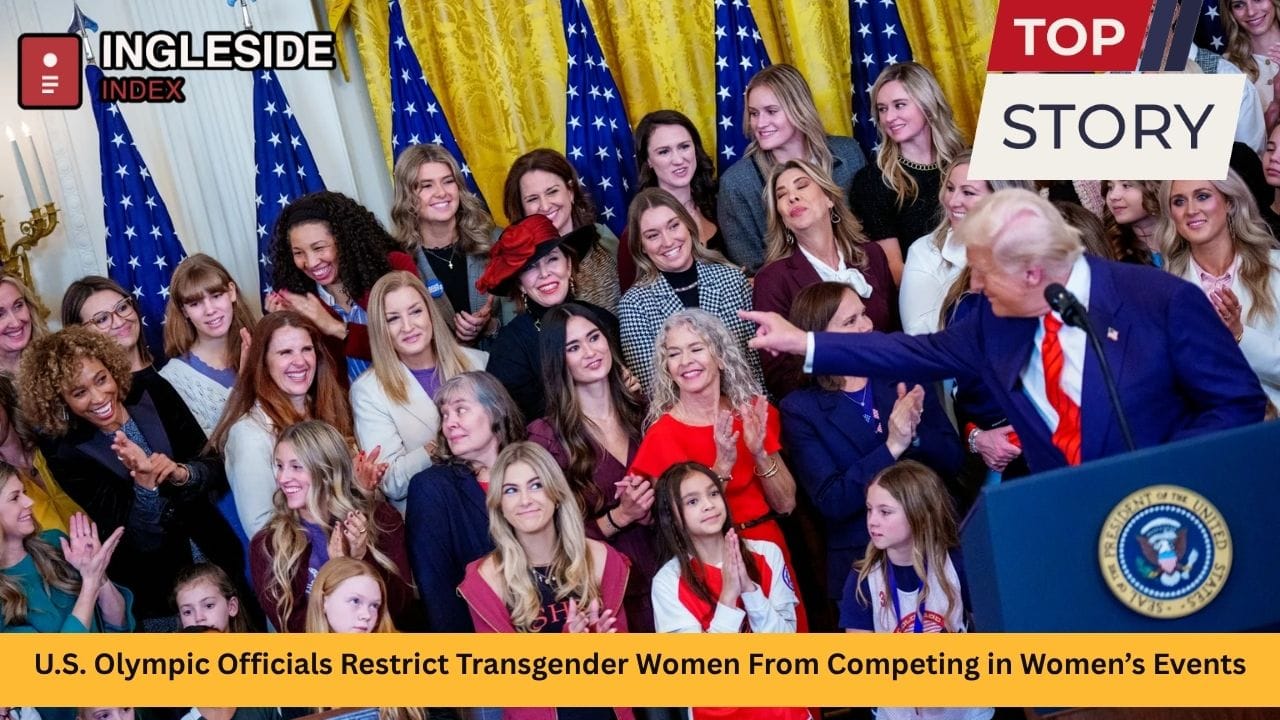Over the past decade, the debate regarding inclusion and fairness in women’s sports has escalated in the United States. A pivotal moment arrived in July 2025, when the U.S. Olympic & Paralympic Committee (USOPC), headquartered in Colorado Springs, discreetly revised its eligibility guidelines. These new rules now prohibit transgender women from participating in women’s Olympic competitions, aligning with recent federal directives. This decision has sparked national discussion and drawn international attention, especially with the Paris 2024 Olympics having only recently set precedence with increased transgender athlete restrictions.
This article delves deeply into the details of the policy change, the national and global repercussions, relevant statistics, athletic case studies, city responses, and voices from all sides of the debate.
The Policy Shift: What Changed?
The USOPC’s recent decision marks one of the most consequential policy reversals in Olympic history for the United States. Previously, decisions about transgender eligibility were often left to individual sport governing bodies, consistent with the International Olympic Committee’s principle of sports autonomy. With this policy change, however, the decision-making power centralized at the federal level, aiming for uniformity across all Olympic disciplines.
Behind this move is President Trump’s Executive Order 14201, titled “Keeping Men Out of Women’s Sports.” The order, signed earlier in 2025, mandated that all federally supported athletic institutions limit women’s competitions to athletes assigned female at birth. The USOPC’s updated Athlete Safety Policy incorporates language conforming to this executive directive, even while avoiding explicit mention of transgender athletes.
Details of the New Guidelines
The USOPC’s updated guidelines, published in July 2025, apply to all national governing bodies operating under the Olympic umbrella—from youth leagues to elite-level teams. The language of the policy is notably ambiguous, referring to compliance with Executive Order 14201 and pledging support for “fair and safe competition environments for women.” The guidelines do not provide explicit procedures for enforcing the ban; instead, they shift the requirement for compliance onto the sport-specific governing bodies, from USA Track & Field in Indianapolis to USA Swimming in Colorado Springs.
The policy effectively removes transgender women from eligibility in women’s Olympic qualifiers, national championships, and all women’s Olympic events organized by U.S. bodies. It also compels local governing bodies in cities like Chicago, Los Angeles, New York, and Atlanta to align with the federal directive if their athletes are participating in Olympic-sanctioned events.
Understanding the Historical Context
Inclusion of Transgender Athletes in the Olympics
Until the mid-2010s, transgender athletes wishing to compete in the women’s category faced stringent criteria, such as requiring gender-confirming surgery and legal recognition of their gender. In 2015, the International Olympic Committee relaxed its policies, allowing transgender women to compete without surgery, provided their testosterone levels were below a certain threshold for at least 12 months before competition.
This evolution led to the historic participation of athletes like New Zealand’s Laurel Hubbard, who competed in weightlifting at the Tokyo 2020 Olympics (held in 2021 due to the pandemic). In the United States, figures such as BMX rider Chelsea Wolfe and swimmer Lia Thomas became symbols of a growing movement for trans inclusion in sport.
The Escalation of Restrictions
In response to ongoing debates about fairness, several international sports federations, such as World Athletics and World Aquatics, made their eligibility rules stricter. By 2024, they required transgender women to have transitioned before the age of 12 to compete in women’s categories at elite levels, citing concerns over “biological advantage.” The Paris 2024 Olympics, noted for its gender parity in medal events, was the first Games with significant new limits on transgender participation.
Reactions Across American Cities
The new USOPC policy reverberated through sports communities and city governments alike. Larger metropolitan areas—known for transgender inclusion efforts, such as San Francisco, Seattle, and New York City—expressed strong opposition, arguing the guidelines contradict local non-discrimination ordinances. In contrast, other regions, particularly in the southern and central U.S., praised the decision as a measure to ensure women’s competitive fairness.
San Francisco
San Francisco’s Department of Health and LGBTQ+ advocates criticized the change as a rollback of civil rights. The city’s recreation centers and school-based athletic programs, previously open to transgender athletes according to affirming local laws, began a review of participation policies for events feeding into national Olympic pipelines.
Los Angeles
In Los Angeles, the host of the 2028 Summer Olympics, city officials expressed concern that the conflict between USOPC policy and city ordinances may complicate preparations for the Games. With the LA28 organizing committee pledging to ensure access and inclusion for all athletes, they now face the challenge of federal compliance versus contractual Olympic commitments.
Atlanta and Dallas
Atlanta, long a stronghold of women’s Olympic athletes, and Dallas, home to several leading youth sports programs, saw local sports authorities divided. While some praised the restoration of what they see as a level playing field, others warned about the exclusionary consequences for aspiring transgender youth.
The National Debate: Fairness Versus Inclusion
The core of the issue rests on contrasting beliefs about fairness and inclusion in sport. Supporters of the ban argue that transgender women may retain physical advantages if their gender transition occurs after puberty, making competition unequal for cisgender women. Opponents counter that trans women are often at a disadvantage due to social, economic, and medical hurdles, and that broad bans are discriminatory.
Athletes’ stories from across cities like Boston, Houston, Portland, and Denver have fueled the debate on both sides.
Arguments Cited by Supporters
-
Preservation of women’s sports as a safe and fair space.
-
Claims of “biological advantage” post-puberty.
-
High-profile cases where transgender women have won titles in women’s competitions.
Arguments Cited by Opponents
-
Scientific studies indicating no automatic or significant advantage for transgender women after hormone therapy.
-
History of trans women competing for decades without dominating women’s sports.
-
Exclusion could cause harm to transgender youth, discouraging participation and athletic development.
Statistics and Insights
Demographics in Women’s Sports
-
According to recent surveys, there are over 1.6 million transgender and non-binary Americans, with about 19% being younger than 18. Of these, a small fraction participate in structured sports at competitive levels.
-
In the 2023-2024 academic year, about 280,000 girls participated in high school track and field, and over 450,000 in soccer, according to data from the National Federation of State High School Associations. Only a minuscule number of these identified as transgender.
-
National Collegiate Athletic Association (NCAA) data indicates that transgender athletes make up less than 0.5% of all registered collegiate athletes.
Olympians
-
Since Laurel Hubbard’s appearance in 2021, only a handful of openly transgender women have qualified for championships or Olympic-level events.
-
Nikki Hiltz, a transgender and non-binary runner representing the U.S., set a U.S. Olympic trials record in the 1,500m in 2024 and is competing in Paris. Hiltz competes in the women’s category, while non-binary, and follows current eligibility rules.
Notable Athletic Cases and Their Impact
Laurel Hubbard (New Zealand, Tokyo 2020)
Hubbard became the first openly transgender woman to compete at the Olympics, in weightlifting. Her participation drew worldwide attention and both backlash and acclaim. Notably, Hubbard did not medal, as her performance was modest compared to other athletes.
Chelsea Wolfe (U.S., BMX, Tokyo 2020)
Wolfe was an alternate for Team USA’s BMX squad. After new cycling federation rules, Wolfe was not eligible to compete in Paris 2024. The decision highlighted that federation-level bans often predate national policies.
Lia Thomas (U.S., Swimming)
Thomas, competing for the University of Pennsylvania, became the first transgender woman to win a National Collegiate Athletic Association Division I title in 2022 in Atlanta, Georgia. Despite legal challenges, Thomas has not been eligible for the Olympic women’s team due to international swimming rules requiring transition before age 12.
How U.S. Cities Are Responding
New York City
In New York, advocates organized rallies outside Madison Square Garden and the USOPC regional office. School sporting events in all five boroughs clarified that while city policy is inclusive, any event that advances athletes to Olympic qualifiers must follow USOPC eligibility.
Chicago
Public school officials and athletic directors convened emergency meetings to discuss compliance. Chicago’s large, diverse sporting community, home to national governing bodies for both boxing and judo, faces difficult decisions balancing inclusivity and Olympic participation.
Seattle and Portland
Both cities’ parks departments, known for robust youth athletics and clubs, have called for federal clarity and scientific review, expressing a desire to see fair play balanced with broad inclusion.
International Context and Comparisons
Globally, the discourse is similarly divided. The International Olympic Committee (IOC), based in Lausanne, Switzerland, continues to leave most eligibility decisions to international federations. In Europe, cities like Paris and Berlin have adopted similarly strict policies ahead of major events.
Other countries, such as Canada and Australia, have introduced nuanced frameworks where participation is judged on a sport-by-sport basis, with medical panels and athlete liaisons tasked with ensuring fairness and inclusion.
The Impact on Future Olympics
Paris 2024
The Paris Games have heightened restrictions: international federations in athletics, swimming, rowing, and cycling now require transgender women to have transitioned prior to age 12. The Games are set to feature the highest number of women athletes in Olympic history, with 50% of medal events for women.
Although a few transgender and non-binary athletes will attend, many who previously competed (or hoped to) have been excluded by the new rules.
Los Angeles 2028
With the U.S. set to host the Olympics in Los Angeles, discussions have begun regarding how the city’s inclusive ethos will align with the federal requirements. Organizers face conflicting commitments: the Olympic Charter’s focus on non-discrimination versus Executive Order 14201’s strict definition of eligibility.
Legal Challenges and the Future
Several advocacy organizations, including those based in Washington, D.C., and San Francisco, have announced lawsuits challenging the new policies. At the same time, the U.S. Supreme Court is preparing to hear high-profile cases regarding state laws on transgender sports participation. While these cases are not directly about Olympic sports, their outcomes may influence wider athletic eligibility norms in the country.
Cities such as Boston, Austin, and Phoenix are watching closely, anticipating that the results may alter their own athletic policies in the coming years.
The Human Side: Athlete Voices and Community Impact
Athletes across the United States have shared heartfelt responses. Some cisgender women, including high school track runners in Houston and collegiate volleyball players in Minneapolis, expressed support, feeling their opportunities are being preserved. Others, such as rowing teams in Philadelphia and Denver, fear the loss of teammates and friends.
Former Olympians, like Megan Rapinoe from Seattle and Allyson Felix from Los Angeles, have publicly called for policies that “honor both inclusion and fairness,” advocating for expert-led reviews and athlete-centered solutions.
Media Coverage and Public Sentiment
Media outlets from Boston to San Diego have covered the policy shift with a mixture of analysis and opinion. Polling in spring 2025 found that American public opinion is sharply divided, with a slight majority favoring restrictions on transgender participation in women’s sport, but sizable minorities in major metropolitan areas supporting trans inclusion.
Social media reactions have ranged from organized campaigns supporting trans athletes to hashtags pushing for the protection of women’s sports, reflecting the country’s broader cultural divide.
Scientific Research and the Role of Experts
Research from universities, including those in Palo Alto (Stanford) and Atlanta (Emory), continues to probe whether trans women retain distinct athletic advantage after hormone therapy. The medical consensus remains contested, with different studies and athletic federations interpreting the science in divergent ways.
Prominent sports medicine specialists, bioethicists, and statisticians have called for greater data transparency and longer-term monitoring, noting that so far, transgender women have not dominated women’s competitions at any level.
Navigating the Path Forward
The policy change by the USOPC is more than a bureaucratic update; it symbolizes a pivotal juncture in the American understanding of gender, fairness, and the Olympic spirit. As the United States approaches the Los Angeles 2028 Games, with millions invested in new facilities and with over 15,000 athletes expected to compete, the pressure to resolve these tensions will only increase.
Cities, athletes, coaches, and sports organizations from coast to coast are now in the process of implementing, challenging, and morally debating the new policy. The next few years will likely see shifts both in legal frameworks and in the cultural perception of women’s sport in America.
Conclusion
The USOPC’s ban on transgender women in women’s Olympic competitions marks a significant shift in American sports—inclusive practices, legal standards, and the Olympic dream itself. Cities from New York to Los Angeles, Houston to Seattle, are now at the forefront of this rapidly evolving discussion. As legal battles unfold and public opinion adapts, the fate of transgender Olympic hopefuls and the very meaning of fairness in sport remain powerfully debated topics. The conversation, as well as the athletes’ dreams, continues to move forward, city by city and story by story, across the United States.




